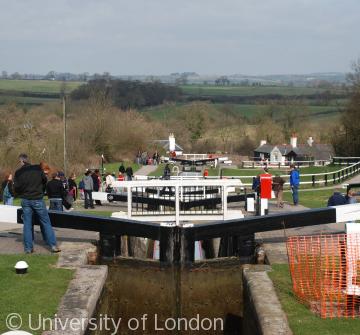Canals
 Foxton Locks in Leicestershire, two 'staircases' of five locks built in 1814
Foxton Locks in Leicestershire, two 'staircases' of five locks built in 1814The waterways of England have been exploited for the transit of materials and goods since prehistory, with the transportation of the Stonehenge Bluestones on rafts or barges along the rivers Avon and Frome around 2000 BC the most well known example. But it was not until the second half of the 18th century that a network of artificially created, navigable waterways was created with the specific purpose of transporting raw materials and finished goods in large quantities, quickly and efficiently.
River borne trade played a major part in the development of many English settlements during the medieval period because the movement of bulk goods could be massively cheaper than road transport. Place name evidence suggests that by the late Anglo-Saxon period, the River Thames was a major transport artery with numerous unloading points. The importance of the Thames for transporting goods led in turn to the creation of planned riverside settlements such as Henley-on-Thames which was laid out as a planned riverside town, most likely in the late 12th century.
Port towns such as Sunderland were also reliant on navigable waterways for the movement of bulk goods. During the 17th century, Sunderland was transformed from a small fishing village to a flourishing port, thanks to the transportation of coal, mined around New Bridge and Lumley, to the west of Sunderland and conveyed along the River Wear in flat bottomed lighters and other small vessels to large, sea-going collier ships.
Natural waterways however, were not always navigable. Unpredictable currents, sandbanks and shallow drafts meant that in many areas, transportation of bulk materials was confined to the roads and packhorse trains, increasing the time and cost of carriage. By the mid-18th century, increased demand led industrialists to seek a faster and cheaper way of transporting won coal from their isolated mines to the industrialising urban centres.
Frustrated by the cost of transporting coal from his mines at Worsley to Manchester using either, the Mersey and Irwell Navigation or packhorse trains, the 3rd Duke of Bridgewater commissioned a canal to be built between Worsley and Manchester, linked to an underground canal at the mines. The Duke commissioned the engineer James Brindley to survey the route, which although requiring no locks to traverse gradients, did require the construction of an aqueduct to cross the River Irwell. The route received an Act of Parliament in 1760 empowering its construction and the canal opened in 1761.
Believed by many to be the first true canal in the modern sense, the Bridgewater Canal was an immediate success, with a single horse able to tow as much as 30 tonnes and inspired an intense period of canal building which was only tempered by the birth of the railways. Fortunes were made by industrialists who successfully gained Parliamentary assent for canals which linked their concerns to major local markets. Men like Sir Richard Arkwright, who benefitted greatly from the construction of the Cromford Canal in 1794 which linked his cotton spinning mills in the Derwent valley with the Erewash Canal.
The topography of the Peak District posed a number of problems for the Cromford Canal and four tunnels and fourteen locks were constructed to carry the route surveyed by William Jessop. These types of engineering challenges saw dramatic advances in tunnelling technology and the construction of raised aqueducts and flights of locks. During the construction of the Harecastle Tunnel on the Trent and Mersey Canal in the early 1770s, James Brindley realised that a reduction in the width of his tunnel would dramatically reduce the cost of its construction and reduced its width to nine feet, in the process removing the towpath and meaning the boatmen had to ‘leg’ their way through the tunnel. These narrow stretches of the early canal network, also dictated the construction of canal boats, being restricted in width to seven feet and creating their distinctive appearance.
By the time that the Liverpool Manchester Railway opened in 1830, over 4000 miles of canals had been built complete with a number of major works of engineering such as the Higham and Strood Tunnel, built as part of the Thames Medway Canal. At 2.25 miles long it is the second longest canal tunnel in the United Kingdom. However by the time canal opened in 1824, the ‘Golden Age’ of British canals was coming to an end and from 1845, the tunnel was used by the Gravesend and Strood Railway, with a single line resting partly on the tow path and partly on wooden stakes in the water.
As the popularity of the railways grew, the canals became less prominent, with many new railway lines following the route of redundant canals, as at Ledbury in Herefordshire. However it was the development of the modern road network in the 20th century, with the associated increases in speed of transit and reduction in costs which brought an end to the canal network as a major means of transportation before the dramatic growth of canal boat holidays in the late 20th century have seen the canals experience a renaissance.


